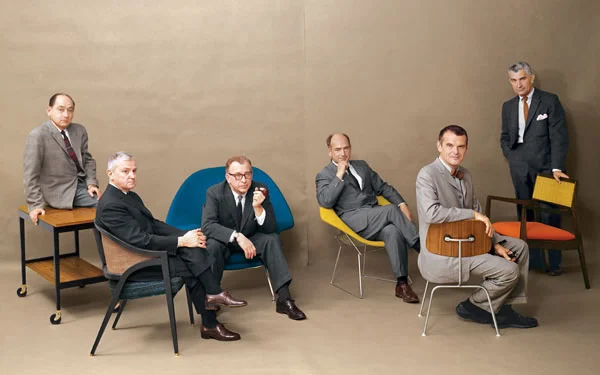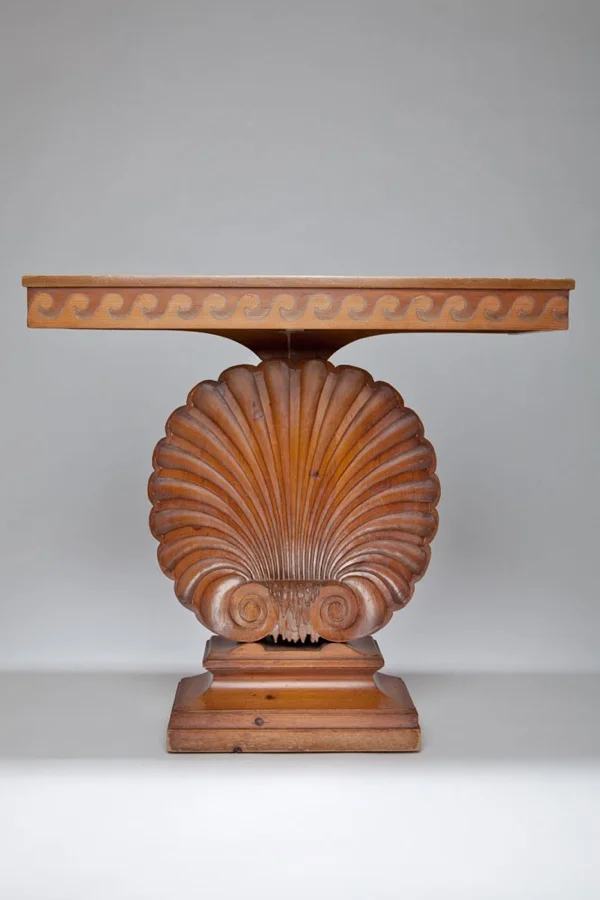DESIGN DICTIONARY: Edward Wormley
"Modernism means freedom—freedom to mix, to choose, to change, to embrace the new but to hold fast to what is good."--Edward Wormley
Introduction
I wrote a post on Edward Wormley about a month after I first started blogging That was a while back. Even though his last name sounds like it came from the Harry Potter series, with words like "elegant," "clean-lined," and "timeless" commonly used to describe his designs, it is time for a reprise.
Edward Wormley is among modernism's great designers. In Playboy's 1961 iconic photo, he is sitting second from the left, together with Harry Bertoia, Eero Saarinen, and Charles Eames. All of them rest in a chair of their own design. Wormley enjoyed great success for 4 decades and then fell into relative obscurity for 3.
After the Lin- Wienberg Gallery's 1997 landmark exhibition of his work, Wormley's furniture became highly sought after once again. Collectors will find the catalog for the exhibition essential. Now Wormley is a decorator's darling and his designs command high prices at auction and in galleries.
Key Characteristic
What is the most important thing you should know about Edward Wormley?
His work is distinguished from the other designers in the 1961 photo because he had a reverence for historical forms and often massaged them to make something unique. This nod to the past set him apart from the more avant-garde designs of his colleagues from the period. House Beautiful said it best: "Wormley's outstanding characteristic is his ability to design modern furniture that fits into period homes and period furniture with a modern cast to it. "
The majority of Edward Wormley's furniture was designed for the company Dunbar, who continues to offer some of his most iconic pieces today. Even the Dunbar ads for Wormley's furniture are collectible, and one of the most charming campaigns from that Mad Men period. It is enchanting and highly original how Dunbar often placed the furniture in an outdoor setting. Other than Dunbar, Wormley produced one collection, called Precedent, for the Drexel Furniture Company. Dunbar quickly asked him to stop, deeming the Drexel relationship a conflict of interest.
Influences
Edward Wormley's upbringing influenced his work. He was raised in a home of modest means. His interest in design began early when he took a correspondence course in decorating while in high school. Perhaps this upbringing drove him to design furniture with precise uses in mind and caused him to consider consumers with modest needs and limited budgets. He strove to make his pieces livable.
After 3 terms at the Art Institute of Chicago (though an outstanding student, he ran out of money and couldn't finish), Wormley landed a job with Marshall Field. There he designed an 18th century English reproduction furniture collection. It was never produced because the Depression intervened, but his work studying antiques had a life long impact.
Frequent trips to Europe also shaped Wormley's design sensibility. On one, he arranged to meet the architect and designer Le Corbusier and the Art Deco master Emile-Jacques Ruhlmann. The popular Scandinavian designs of his day also influenced Wormley. This chair is a particularly strong example of the Scandi sway.
Janus Collection
Launched in 1957, the Janus collection is one of Wormley's most sought after collections for Dunbar. Wormley, one of the earliest collectors of Tiffany glass (well before it was popular), decided to create a modern collection inspired by the Arts and Crafts period, citing California architects Greene and Greene as a source of inspiration. The collection would incorporate design details such as inlaid tiles, both from Tiffany and later Natzler and antique Japanese woodblocks.
Many of his pieces remained in Dunbar's collections for years, with one best-selling sofa in 1961, being first introduced in 1949. Some favorites acquired catchy names such as the "Listen to Me" chaise, the "Tete-a-Tete" sofa, the "Sheaf of Wheat table" and the "Long John coffee table."
Today's Homes
Today's designers remain enamored by Wormley and seek to include his enduring designs in their finest rooms.
Credits: Wormley quote from the Industrial Designers of America, House Beautiful quote from Todd Merrill's book Modern Americana. Playboy coverblue chair from 1st dibsshell console via deco phobia Janus cabinet from 1st dibs Occasional table collage from 1st dibs, Christies and Art Value. Collage, Edward Wormley from Collect Dunbar, Listen to Me Chaise from Red Modern furniture, Tete-a-tete sofa from 1st dibs Sheaf of Wheat table from 1st dibs, Long John Coffee table from icollector Photographs of Matthew Patrick Smyth's room at Holiday House by Lynn Byrne.
















